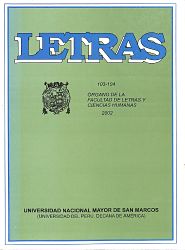Scriptural formalization
Keywords:
Language, Writting
Abstract
All languages in the world emerged as exclusively acoustic (or oral) forms and in the most natural and unconscious way, as recorded in human history. From this they have been taking a graphic model and thus have been able to respond, with ever greater efficiency, to social demands, which in their turn were also more complex. Oral or auditory forms are transferred into visual models. Through this process the messages become reading material. The language, in this case, is fully cultural, audiovisual.Downloads
Download data is not yet available.
Métricas alternativas
References
CHÁVEZ REYES, Amando. Normalización del quechua, ¡989. Huaraz, UNA-SAM, 1994.
"Lenguaje y política", en revista Ciencia, Tecnología y Humanidades, UNASAM, Huaraz.
Aspectos formales de la palabra castellana. Lima, Fondo Editorial de la Universidad Nacional Mayor de San Marcos, 1998.
FASOLD, Ralph. La sociolingüística de la sociedad.
GARVIN, Paúl y Yolanda LASTRA. Antología de estudios de etnolingüística y sociolingüística. México, UNAM, 1974.
LABOR, William. Modelos sociolingüísticos. Madrid, Cátedra, 1983.
MARÍN MARCOS, Francisco y Jesús SÁNCHEZ LOBATO. Lingüística aplicada. Madrid, Ed. Síntesis, 2001.
TARELLO, Fernando. A Pesquisa Sociolingüística. 2a. ed. Sao Paulo, 1986.
TORSTEN, Husén y Susán OPPER. Educación multicultural y multilingüe. Narcea Ediciones, 1983.
ZÚÑIGA, Madeleine. y otros. Educación bilingüe intercultural. Lima, Fomciencias, 1991.
"Lenguaje y política", en revista Ciencia, Tecnología y Humanidades, UNASAM, Huaraz.
Aspectos formales de la palabra castellana. Lima, Fondo Editorial de la Universidad Nacional Mayor de San Marcos, 1998.
FASOLD, Ralph. La sociolingüística de la sociedad.
GARVIN, Paúl y Yolanda LASTRA. Antología de estudios de etnolingüística y sociolingüística. México, UNAM, 1974.
LABOR, William. Modelos sociolingüísticos. Madrid, Cátedra, 1983.
MARÍN MARCOS, Francisco y Jesús SÁNCHEZ LOBATO. Lingüística aplicada. Madrid, Ed. Síntesis, 2001.
TARELLO, Fernando. A Pesquisa Sociolingüística. 2a. ed. Sao Paulo, 1986.
TORSTEN, Husén y Susán OPPER. Educación multicultural y multilingüe. Narcea Ediciones, 1983.
ZÚÑIGA, Madeleine. y otros. Educación bilingüe intercultural. Lima, Fomciencias, 1991.
Published
2002-12-31
How to Cite
Chávez Reyes, A. (2002). Scriptural formalization. Letras (Lima), 73(103-104), 199-210. https://doi.org/10.30920/letras.73.103-104.15
Section
Linguistics
Copyright (c) 2002 Letras (Lima)

This work is licensed under a Creative Commons Attribution 4.0 International License.
Este obra está bajo una licencia de Creative Commons Reconocimiento 4.0 Internacional



















